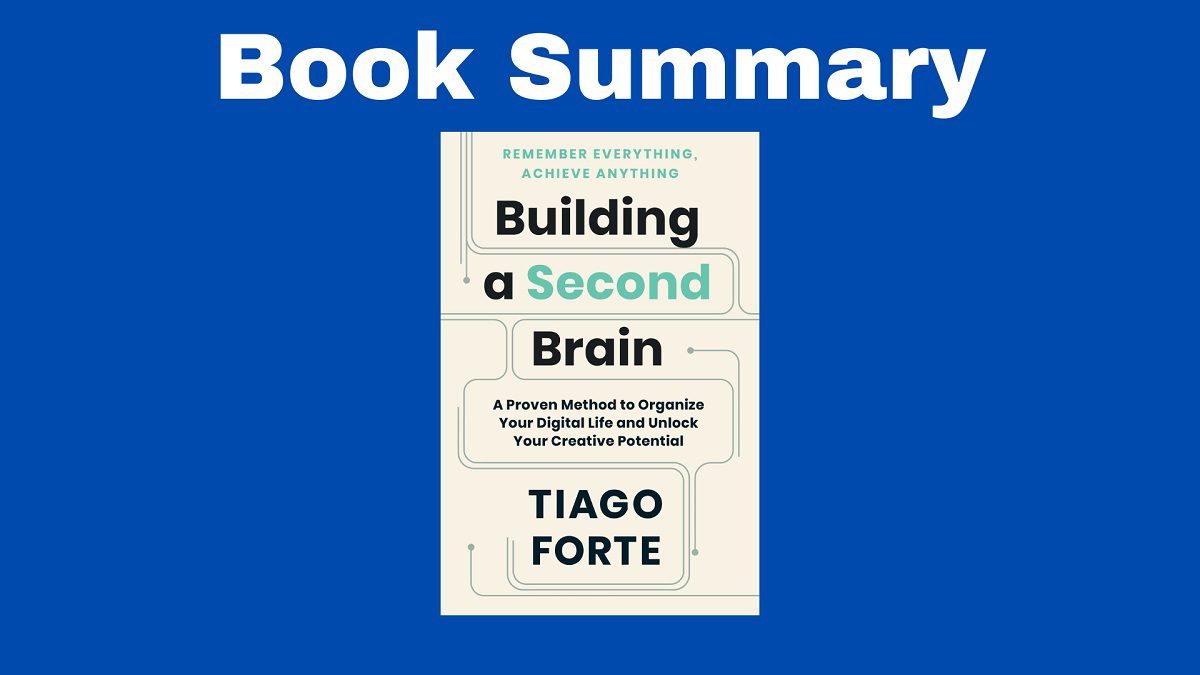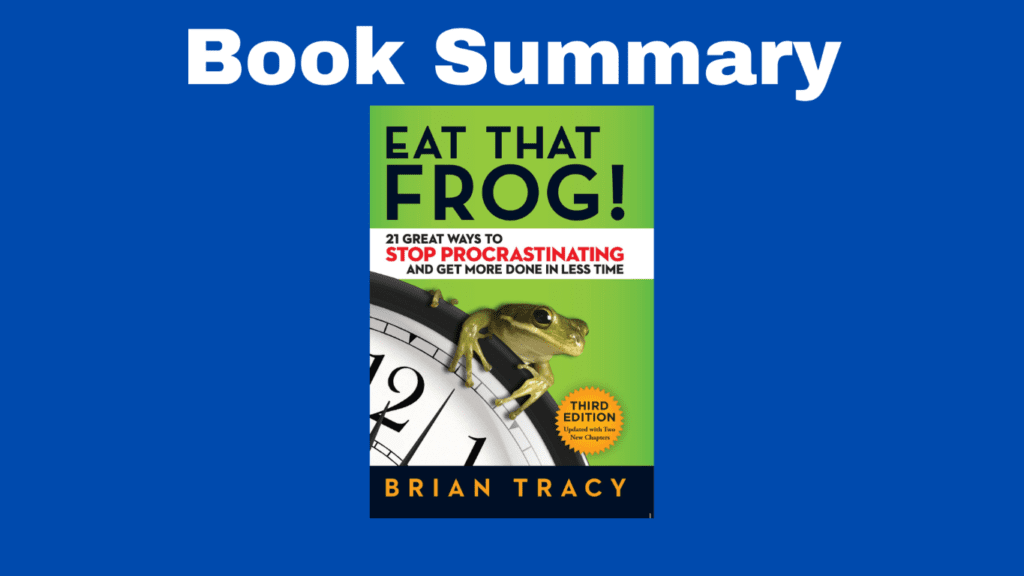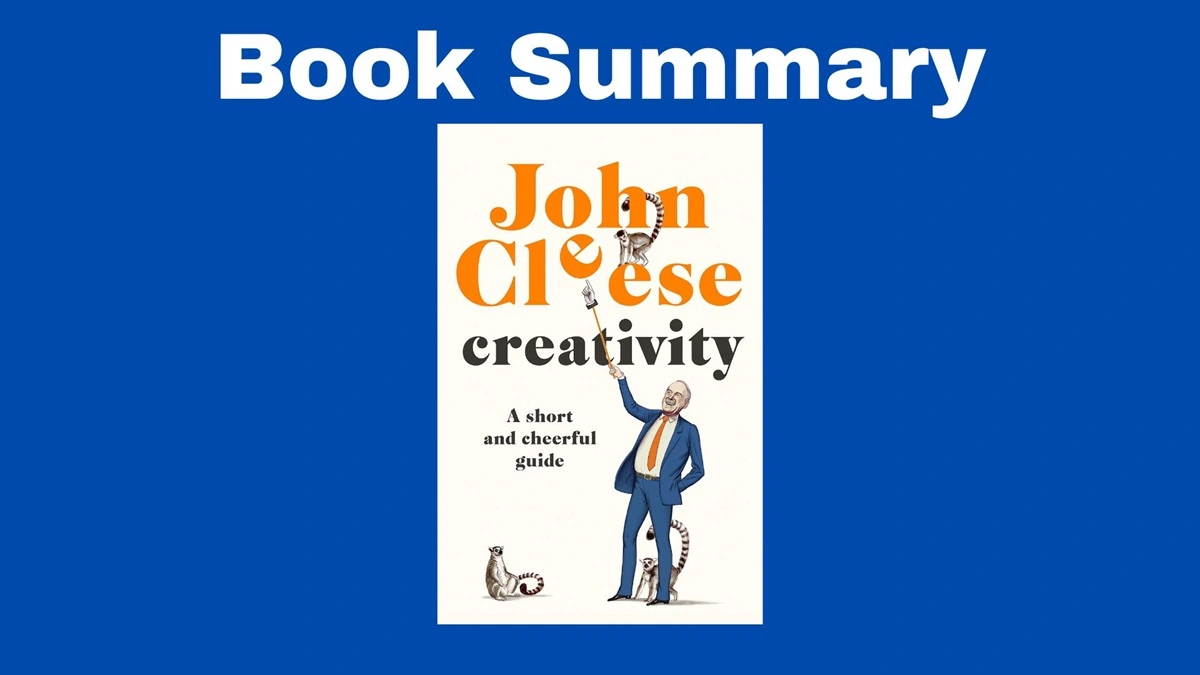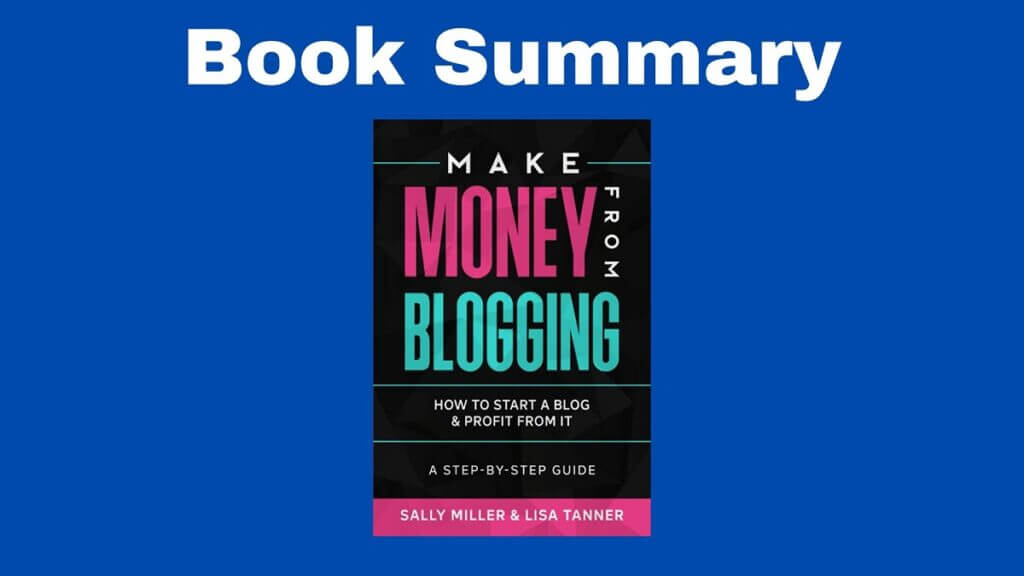The Book in Three Sentences
In this summary of Building a Second Brain, you’ll learn a productivity system that helps you organize your work and your life. For those unfamiliar, a Second Brain is a digital space that serves as our personal assistant for knowledge management. In this workspace, we can keep lists, notes, and ideas synced across several devices so that we can access them whenever we want.
Building a Second Brain Summary
Introduction: The Promise of a Second Brain
Nowadays, we’re exposed to more information than we can absorb and this makes us more anxious. There’s value to the information we consume online, but we’re usually consuming it at the wrong time. Undoubtedly, that information will become more relevant in the future, but to access it, we have to make it accessible. The tool that enables us to do that is a system called Building a Second Brain and it’s based on personal knowledge management or PKM.
Among other things, the Second Brain will help you:
- Find anything you’ve learned in seconds
- Organize knowledge to move your goals forward
- Connect ideas
- Have a trusted system that lets you relax
- Spend less time looking for things and more time creating
Part One: The Foundation: Understanding What’s Possible
Chapter 1: Where It All Started
At a young age, the author suffered from memory loss and the doctors didn’t know why, so he decided to start a journal, take down notes and digitalize documents. This notetaking system helped Tiago Forte graduate from college, become an English teacher, and land a job as an analyst. As soon as he had the chance, Tiago started teaching this framework to others.
Chapter 2: What Is a Second Brain?
Currently, information is the building block of everything: work-related projects, getting a job, learning a skill, and starting a business. But the problem is that information overwhelms us. Since we never seem to find the information we need, we rely on our biological brains which are not prepared to retain too many ideas.
For centuries, people have written things down in order to remember them and use them later. This is called a “commonplace book”. Our commonplace book should be digital in order to search, organize, and synchronize our notes. The Second Brain is a notebook, journal, and sketchbook for ideas. Your smartphone is at the center of everything, but instead of using it to kill time, you should use it as a tool that adds value to your life.
Chapter 3: How a Second Brain Works
The Second Brain is the world’s best personal assistant because it’s both reliable and consistent.
There are four essential capabilities that the Second Brain needs to perform:
- Make ideas concrete: we declutter ideas of complex ideas to work effectively.
- Reveal new associations between ideas: creativity is about connecting ideas.
- Incubate ideas: we tend to favor ideas that came up recently, but if we think about something for long periods of time, we’ll come up with better ideas.
- Sharpen perspective: let your own thinking shine.
The centerpiece of your Second Brain is the digital note-taking app of your choice. This app is:
- Multimedia
- Informal
- Open-ended
- Action-oriented
There are three stages of progress in the Second Brain journey: remembering, connecting, and creating. This can be summed up by the CODE method which stands for capture, organize, distill, and express.
- Capture: keep what resonates. We need to curate the information that comes our way.
- Organize: save for actionability. Organize for action, and organize by projects.
- Distill: find the essence. Summarize the main points of something in a few sentences.
- Express: show your work. Share your ideas with others.
Part Two: The Method: The Four Steps of CODE
Capture 4: Capture – Keep What Resonates
In a way, we keep information to survive, but we need to determine what kind of information is right for us. Whether we like it or not, we are what we consume. Therefore, we can use our Second Brain as a filter to curate that information and determine what we need more of or less of. A knowledge asset is a piece of information that can be used in the future. There can be external knowledge assets and inner knowledge assets.
External knowledge assets:
- Highlights
- Quotes
- Bookmarks and favorites
- Voice memos
- Meeting notes
- Images
- Takeaways
Inner knowledge assets:
- Stories
- Insights
- Memories
- Reflections
- Musings
What not to keep on our Second Brain:
- Sensitive information you’d like to keep secure
- A special format or file type
- Large files
- Collaborative notes
The twelve favorite problems is a framework inspired by physicist Richard Feynman. He said you should keep twelve of your favorite problems always present. When you learn something new, check if you can answer one of those twelve open-ended questions. So the idea is to come up with a series of problems you’d like to solve and work on them over extended periods of time. When you come across something you’d like to solve, don’t look at it as valuable in its entirety. There are certain parts that are more valuable than others, so save those parts only. In other words, curate, be picky, and don’t hoard.
To know what’s worth saving, use the following criteria:
- Capture Criteria #1: does it inspire me? Inspiration is rare. Keep a collection of inspiring things.
- Capture Criteria #2: is it useful? When you find something that might come in handy in the future, save it.
- Capture Criteria #3: is it personal? Keep personal information, your own reflections, memories, anecdotes, or mementos.
- Capture Criteria #4: is it surprising? The information you keep should surprise you in some form. If it doesn’t surprise you, then you already know about it.
To sum up, capture what resonates. This is your intuition telling you that something is worth keeping. Also, don’t forget to capture the sources, as well as key information from them since this might come in handy in the future.
Capture tools include:
- Ebook apps
- Read later apps
- Basic notes apps
- Social media apps
- Web clippers
- Audio/voice transcription apps
- Additional third-party services
Some ways of using capture tools include:
- Capturing passages from ebooks
- Capturing excerpts from online articles
- Capturing quotes from podcasts
- Capturing voice memos
- Capturing parts of YouTube videos
- Capturing excerpts from emails
- Capturing content from other apps
Remember that there’s no right or wrong way to capture. As a general rule, don’t capture more than 10% of the original source.
Chapter 5: Organize – Save for Accountability
Our digital environment should be intentional. Apart from capturing notes, you also need an effective way to organize and retrieve them. To organize your digital space, answer this question: “in which project is this more useful?” Once you have your answer, the information you collect should support the projects you have. There should be four main categories: Projects, Areas, Resources, and Archives. This is the PARA system.
- Projects for short-term goals
- Areas for long-term responsibilities
- Resources for topics or interests you save for the future
- Archives for inactive items that are no longer part of the other three categories”
Here’s a more detailed look at each of the categories of the PARA system:
- Projects have a beginning and an end, as well as a timeframe. They have a clear outcome and projects help you prioritize, plan, and get rid of the unessential.
- Areas, on the other hand, don’t have an end date or objective. These can be activities, people, standards of performance, departments, or teams you’re responsible for. Though there’s no goal, they’re extremely important.
- These are the topics you’re interested in.
- These are the items from the aforementioned categories that are no longer active.
Place notes or files where they’ll be useful and where they’ll be useful the soonest.
To think about your current projects:
- Notice what’s on your mind
- Look at your calendar
- Look at your to-do list
- Look at your computer, downloads folder, bookmarks, emails, or open browser tabs
Chapter 6: Distill – Find the Essence
Our notes aren’t for collecting, they’re for using. Furthermore, notes should be easy to discover. With this in mind, distill your notes to their bare essence using a technique called Progressive Summarization. This technique involves highlighting the main points, then highlighting those main points, and so on. Each of these highlights symbolizes a different layer.
Here’s how it works: first, you summarize the main points. Then, you bold the main points, keywords, or phrases. Finally, you highlight passages in bright colors or underline them. You can also include bullet points with a summary in your own words. The first time you’re exposed to a piece of information, you want to see it as a whole, but the next time, you want to see the highlights. Progressive Summarization can be used in all kinds of content, as long as you have access to the text (articles, videos, blog posts, podcasts, and personal notes are some examples).
The three most common notetaking mistakes:
- Overhighlighting: when it comes to highlighting, less is more. You should never highlight more than 10% of the original source.
- Highlighting without a purpose: you highlight when you’re ready to create something out of it.
- Making highlighting difficult: when you highlight, you should follow your intuition.
Chapter 7: Express – Show Your Work
Attention is our greatest resource and one of the goals of the Second Brain is that it frees up our attention. This can be accomplished by dividing work into smaller units. These are intermediate steps or rough drafts known as Intermediate Packets.
There are five kinds of Intermediate Packets:
- Distilled notes
- Outtakes
- Work-in-progress
- Final deliverables
- Documents created by others
Small creative acts eventually become projects of their own. You aren’t building something entirely new since some Intermediate Packets are already part of your Second Brain.
There are four retrieval methods:
- Search: it doesn’t lose time and effort
- Browse: since each workspace should be identified, you can easily find everything related to the task there
- Tags: small labels you use to identify notes
- Serendipity: this is when you find something by sheer luck or creativity
Part Three: The Shift: Making Things Happen
Chapter 8: The Art of Creative Execution
You can plan for creativity. When you sit to do something, the part where you gather and organize the source material needs to be done previously. The products change all the time, but the creative process always remains the same.
A creative endeavor often starts as an act of divergence. You’re open to possibilities as a way to gather new ideas and organize what you’re doing. Convergence is about eliminating options to determine what’s essential.
Strategies for completing projects:
- The Archipelago of Ideas: give yourself stepping stones. Instead of starting from nothing (the sea), you start from a series of interconnected ideas (an archipelago) which is the backbone of your project. This is an outline that is digital, flexible, interactive, detailed, searchable, and easily accessible.
- The Hemingway Bridge: use yesterday’s momentum today. The “Hemingway Bridge” was a technique the author used when he started a writing session and he already knew what came next. Every time he wrote, he knew how to continue. Some ways in which you can use the Hemingway bridge include: writing down ideas for the next steps, writing down the current status, writing down details you might forget, or writing down your intention for the next session.
- Dial Down the Scope: ship something small and concrete. The fewer features your project has, the more focused it’ll be. This is useful when you have limited resources, making some problems more manageable. You can try and start a project with what you already have and build it over time.
Chapter 9: The Essential Habits of Digital Organizers
Your Second Brain enhanced productivity and creativity, but it also needs maintenance. Being organized is a habit and you should automate certain repetitive tasks so that you can focus on the creative part. It’s worth mentioning that we need inner and outer discipline to be productive.
Here are some habits that can help you:
- Project checklists
- Weekly and monthly reviews
- Noticing habits
These are part of the “maintenance schedule”.
You should recycle your knowledge so that you never start a project from scratch. Your attention then becomes an asset you invest in and get something in return which you then reinvest again.
Checklist #1: Project Kickoff
You need organization before you even start a project.
- Capture
- Review folders that have relevant notes
- Search across all folders
- Move relevant notes to the project folder
- Create a project plan
Checklist #2: Project Completion
- Mark Project as complete
- Crossout goals. Move to the “completed” section
- Review Intermediate Packets
- Move projects to archives
- If a project is becoming inactive, add a status note before archiving.
Do a weekly review. This is an idea taken from David Allen’s Getting Things Done method. In this check-in that takes place once a week, you review your work and life. Additionally, you should name your notes and sort them into their PARA folders.
Here’s the author’s weekly review for reference.
- Review and update goals
- Review and Update the project list
- Review areas of responsibility
- Review maybe tasks
- Reprioritize tasks
The author calls “noticing” habits those small opportunities to capture something that might otherwise go unnoticed. An idea that seems outlandish, something that might sound silly or hard to comprehend, combining intermediate Packets into one, and so on.
Chapter 10: The Path to Self-Expression
There’s only so much your biological brain can do. If you have too many tasks at once you’ll feel anxious and stressed. By welcoming a Second Brain into your life, you’re giving your biological brain the time and energy it needs to be imaginative and enjoy life.
Finally, here are twelve practical steps to start your Second Brain:
- Decide what you want to capture
- Choose your notes app
- Choose a capture tool
- Get set up with PARA (projects; areas; resources; archives)
- Identify your twelve favorite problems
- Capture your ebook highlights
- Practice progressive summarization
- Experiment with one Intermediate Packet
- Make progress on one deliverable
- Schedule a weekly review
- Assess your notetaking proficiency
- Join the PKM (Personal Knowledge Management) community
Further Reading
If you enjoyed this book summary of Building a Second Brain, you might also like the following articles:




